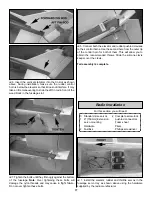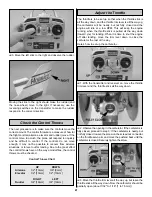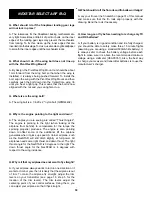
Do not attempt to fly by yourself. The Hobbico NexSTAR
ARF has many features that make learning to fly R/C an
easier experience, but the help from an instructor is
invaluable. An instructor is going to be able to inspect your
airplane to make sure everything is working correctly and
he will also be able to give you a few tips and comments on
how to improve your flying. Also, make sure you fly at an
AMA sanctioned flying field.
Remember, it is assumed that your instructor is operating
the model for you.
Before the model is ready for takeoff, it must first be set up to roll
straight down the runway. With the engine running at a low idle,
place the plane on the runway and, if your flying field permits,
stand behind the model. Advance the throttle just enough to
allow the model to roll. If the model does not roll straight down
the runway, shut the engine off and adjust the nose gear
pushrod as necessary. Do not use the rudder trim to correct the
nose wheel because this will also affect the rudder. Note:
Crosswinds may affect the direction the model rolls, so this test
should be done in calm conditions, or with the model facing
directly into the wind.
If possible, takeoff directly into the wind. If you are experienced,
taking off in a crosswind is permissible (and sometimes
necessary—depending upon the prevailing wind conditions and
runway heading). Taking off into the wind will help the model roll
straight and also reduces ground speed for takeoff. Taxi the
model onto the runway or have an assistant carry it out and set
it down, pointing down the runway into the wind. When ready,
gradually advance the throttle while simultaneously using the
left stick (rudder/nose wheel) to steer the model. Gain as much
speed as the runway and flying site will practically allow before
gently applying up elevator lifting the model into the air. Be ready
to make immediate corrections with the ailerons to keep the
wings level, and be smooth on the elevator stick, allowing the
model to establish a gentle climb to a safe altitude before
making the first turn (away from yourself). Do not “yank” back
the elevator stick forcing the plane into too steep of a climb
which could cause the model to quit flying and stall.
Once airborne, maintain a steady climb and make the initial turn
away from the runway. When at a comfortable, safe altitude,
throttle back to slow the model, thus giving you time to think and
react. The Hobbico NexSTAR ARF should fly well at half or
slightly less than half throttle. Adjust the trims so the plane flies
straight and level. After flying around for a while, and while still at
a safe altitude with plenty of fuel, practice slow flight and execute
practice landing approaches by reducing the throttle further to
see how the model handles when coming in to land. Add power
to see how the model climbs as well. Continue to fly around while
learning how the model responds. Mind your fuel level, but use
this first flight to become familiar with the model before landing.
When ready to land, pull the throttle stick fully back while flying
downwind just before making the 180-degree turn toward the
runway. Allow the nose of the model to pitch downward to
gradually bleed off altitude. Continue to lose altitude, but maintain
airspeed by keeping the nose down while turning. Apply up
elevator to level the plane when it reaches the end of the runway
and is about five to ten feet off the ground. If the model is too far
away, carefully add a small amount of power to fly the model
closer. If going too fast, smoothly advance the throttle and allow
the model to gain airspeed, then apply elevator to climbout and
go around to make another attempt. When finally ready to touch
down, continue to apply up elevator, but not so much that the
airplane will climb. Continue to apply up elevator while the plane
descends until it gently touches down.
The NexSTAR ARF has been designed to make steep landing
approaches so that the landing approach is short and easy. The
Speed Brake Training Flaps excel at maintaining flying speed
even in steep dives, and when the airplane is leveled-out, they
also help to increase lift. You can also make a long landing
approach and use throttle to keep the airplane flying at a very
low speed until you reach the runway threshold where you
should cut the throttle for the airplane to land.
After you have landed and shut the engine off, adjust the
pushrods on the ailerons, elevator and rudder as necessary
so the trim levers on the transmitter may be returned to
center. This will not be required on any of the controls that
did not need trim adjustments.
Landing
Flight
Takeoff
Taxiing
IMPORTANT: Be aware of your proximity to R/C club
sites. If there is an R/C site within six miles of where you
are flying, and if you are operating your model on the
same frequency at the same time as somebody else,
there is a strong possibility that one or both models will
crash due to radio interference. There is great potential
for an out-of-control model to cause property damage
and/or severe personal injury. We strongly urge you to fly
at an R/C club site where frequency control is in effect so
you can be assured you will be the only one flying on
your channel.
FLYING
26
Содержание NexStar ARF
Страница 31: ...31 Correct Angle Rods Fin...
Страница 32: ...32...





















